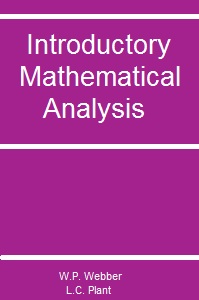Introductory Mathematical Analysis by W.P. Webber, L.C. Plant

About this book :-
"Introductory Mathematical Analysis" by "W.P. Webber" and "L.C. Plant" provides a clear and structured introduction to "mathematical analysis", designed for students progressing from basic calculus to more advanced analytical thinking. The book begins with the fundamentals of the "real number system", functions, and continuity, laying a strong foundation for the study of limits, sequences, and series.
The authors present key topics such as differentiation, integration, and convergence with a balance of rigor and clarity. Each chapter includes examples and exercises that reinforce both conceptual understanding and practical application. Webber and Plant’s approach focuses on making abstract concepts accessible, guiding learners through logical reasoning and problem-solving techniques essential in higher mathematics.
This text serves as an excellent bridge between introductory calculus and advanced real analysis. "Introductory Mathematical Analysis" remains valuable for undergraduate students and self-learners seeking to strengthen their grasp of analytical methods. With its precise explanations and engaging style, the book continues to be a trusted resource for developing a deep and logical understanding of mathematics.
Book Detail :-
Title:
Introductory Mathematical Analysis by W.P. Webber, L.C. Plant
Publisher:
John Wiley & sons
Year:
1919
Pages:
332
Type:
PDF
Language:
English
ISBN-10 #:
B01D69KGX2
ISBN-13 #:
License:
Public Domain Work
Amazon:
Amazon
About Author :-
The author
W. Paul Webber
and "L.C. Plant" were dedicated mathematics educators known for their clear and practical approach to "mathematical analysis". They focused on helping students transition from basic calculus to rigorous analytical reasoning. Their book "Introductory Mathematical Analysis" blends clarity with depth, emphasizing the logical structure behind core mathematical concepts.
Book Contents :-
1. Review of Algebra
2. Geometrical Theorems
3. Methods of Calculation
4. Graphic Representation
5. Ratio Proportion and Variation
6. Rectangular Coordinate System; Graphic Representation of Equations
7. Numbers, Variables, Functions and Limits
8. Circular Trigonometric Functions and their Applications
9. Polar Coordinates, Complex Numbers and Vectors
10. Equations
11. Linear Functions and Straight Line
12. Equations of the Second and Higher degrees and their Graphs
13. Transforamtion of Coordinates
14. Conic Sections
15. Theormes on Limits, Derivatives and their applications
16. Series, Transcendental Functions
17. Integration
Similar
Mathematical Analysis
Books